|
|
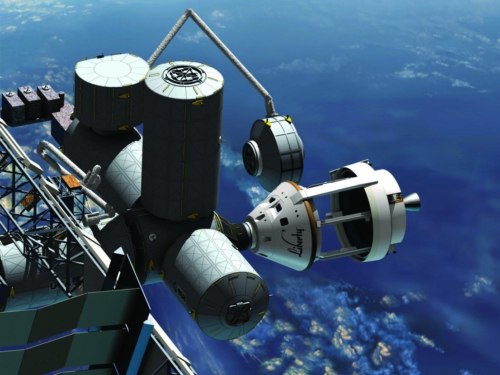 An illustration of the cargo module capability for the ATK/EADS Astrium Liberty system announced in June. (credit: ATK) [ Last in a series of posts about the companies that won and lost in NASA’s Commercial Crew Integrated Capability (CCiCap) competition ]
Of the four companies that submitted CCiCap proposals deemed technically viable by NASA, ATK’s Liberty system was the odd one out, the only one not receiving a funded agreement. That raises the question: will ATK and its partners, notably EADS Astrium, continue to pursue development of the full system or some subset of it, like the launch vehicle?
Since the announcement a week ago ATK has remained quiet. “ATK and the Liberty Team are disappointed that we were not selected by NASA†for a CCiCap award, the company said in a statement last Friday. “We continue to believe Liberty provides the safest, most cost-effective crew and cargo transportation systems, as well as the fastest path to recover America’s human launch capability and engage the workforce and facilities at Kennedy Space Center, Johnson Space Center, and others. We look forward to a debriefing from NASA.â€
The company’s supporters in Congress have been more vocal, though. “I am disappointed and disheartened by the news that NASA has excluded ATK from the companies†that won CCiCap awards, said Rep. Rob Bishop (R-UT) in a statement. “It was my understanding that ATK’s Liberty proposal ranked very high in technical merit, and was the lowest-risk option,†he added, although NASA has yet to disclose the details of its selection process.
In comments Bishop and his office provided to a local newspaper, the Ogden Standard-Examiner, he suggested political factors may have played a role. “I have been concerned that favoritism may be playing far too prominent a role in NASA’s decision-making process, especially with regard to companies closely tied to key NASA officials,†he said, citing among other factors various visits by NASA leadership to some of the companies that won awards but not to ATK.
On Thursday, in a call with financial analysts to discuss the company’s latest quarterly earnings report, ATK president and CEO Mark DeYoung suggested that Liberty was, at the very least, not a priority for the company going forward, if the company even planned to pursue it. He reiterated on a couple occasions that ATK was “disappointed” in the CCiCap decision. “We offered a safe, mature, affordable solution to NASA, and we’re looking forward to learning more about their decision.”
However, he also said that, unlike its work on the Space Launch System and advanced booster concepts related to it, Liberty was not as high a priority for ATK. “Liberty was a little bit of a longer shot for us, so we hadn’t planned on it, so from that view it should not have any significant financial impact for the company,” he said. “Going forward, we’re going to focus on SLS, we’re going to focus on the advanced booster, we’re going to execute on those programs.” He later said that, with regards to commercial crew, “we were disappointed, we’re moving on.”
ATK officials involved with Liberty had previously indicated that the company would continue its efforts on the program if it didn’t get an award, albeit at a slower pace. DeYoung’s comments hint that progress on Liberty could come at a far slower pace—or possibly not at all.
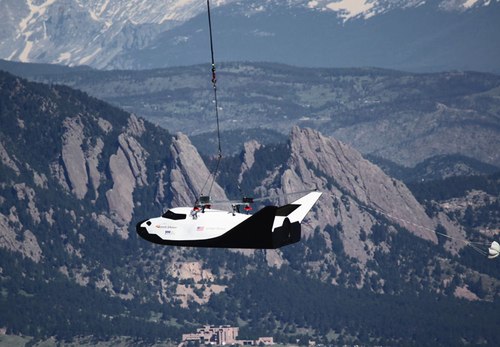 An engineering model of Sierra Nevada Corporation’s Dream Chaser spaceplane during its first captive carry test flight in Colorado in May 2012. (credit: SNC) [ Third in a series of posts about the companies that won and lost in NASA’s Commercial Crew Integrated Capability (CCiCap) competition ]
As part of a June agreement between NASA administrator Charles Bolden and Congressman Frank Wolf (R-VA), chairman of the House appropriations subcommittee with oversight of NASA’s budget, NASA agreed to provide no more than “two and a half” CCiCap awards: two “full” awards and a third “partial” award that would allow that company to remain involved in the program, but at a slower pace. With the CCiCap award announcement Friday, it appeared Sierra Nevada Corporation (SNC) got the “half” award, with a total value of $212.5 million, less than half of either SpaceX’s or Boeing’s awards.
Mark Sirangelo, vice president of SNC and head of it Space Systems division, doesn’t see it that way, telling reporters on a media telecon Friday morning that he feels the company is not behind Boeing and SpaceX for two reasons. “We’re riding the Atlas V rocket, which has now flown 31 times,” he said. “We have a significant amount of rocket risk behind us.” Boeing, of course, is also using the Atlas V, but SpaceX is using its own Falcon 9, which has flown only three times—all successfully—to date.
The other reason, he said, is that Dream Chaser is based on NASA’s HL-20 lifting body design, which the agency developed over the course of a decade. “When you take that history plus the eight years that we’ve been working on it, we actually have a significant amount of work that has been done.” The combination of that spacecraft design heritage and launch vehicle record helps level the playing the field, Sirangelo concluded. “It may appear as though we’re behind, but in our view we think that in many ways we’re more mature.”
While the size of SNC’s Space Act Agreement is smaller than the other two, Sirangelo said it may be possible to get more money through the exercise of additional, optional milestones. On the company’s CCDev-2 award, he said, the company won $25 million in such additional milestones. “We were not the largest award in the base period of the last round, but we wound up actually getting and earning the largest amount of money from that program,” he said.
The current base program features nine milestones, falling short of achieving critical design review (CDR) as was the case with the Boeing and SpaceX awards. “We expect in this phase to conduct a significant amount of work, both on the development of the necessary path to CDR that will be required for the vehicle as well as a significant amount of hardware development,” Sirangelo said. The milestones do include flight testing of an engineering test article and propulsion tests. The original agreement contained between 13 and 20 milestones, Sirangelo said; the tenth, for example, was a full demonstration of their flight simulator, although he declined to go into details about the additional unfunded (for now) milestones.
“We believe that we’re going to be able to maintain the same pace. We’re on schedule and on budget for what we want to do with the program,” Sirangelo concluded. “It’s a very exciting time for us.”
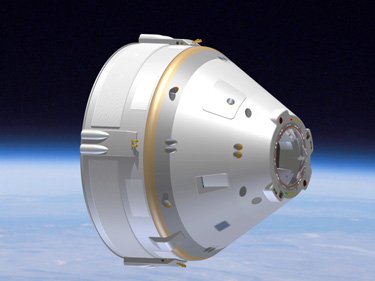 Illustration of Boeing’s proposed CST-100 commercial crew capsule. [ Second in a series of posts about the companies that won and lost in NASA’s Commercial Crew Integrated Capability (CCiCap) competition ]
Boeing received the largest of the three CCiCap awards, at $460 million. That award covers 19 milestones and culminates in April 2014 with a critical design review (CDR). The work included in the agreement covers both CST-100 spacecraft tests as well as work on the Atlas V launch vehicle that will carry it, such as development of a dual-engine Centaur booster stage and tests of the rocket’s emergency detection system.
As you might expect, Boeing officials were pleased with the award. “We’re really excited about today’s announcement,” John Elbon, vice president and general manager of Boeing Space Exploration, said in a conference call Friday morning. “We certainly appreciate the confidence expressed by NASA in selecting us for the next phase of commercial crew development.”
One thing that sets Boeing’s bid apart, company officials said, was the breadth of capabilities at Boeing overall, including in its much larger aircraft business units. “One thing that we have really been aggressive at is looking across Boeing,” said John Mulholland, vice president and program manager of commercial programs within Boeing Space Exploration. “We have been able to bring in innovative approaches to the workflow, to our design. So from across Boeing we have been getting help on being able to incorporate innovative approaches to make our team and our product more efficient.”
Most of the work that Boeing will do under the CCiCap award will be to mature the design from the preliminary design review phase, which it completed under its previous commercial crew award, to the CDR. “We’re taking all the subsystems through design maturation, which includes across-the-board development tests,” said Mulholland. “Along the way we’ll be doing a number of risk-reduction tests.”
Boeing’s award was only slightly modified from what the company proposed in order to bring the total value down from $500 million, Mulholland said. “We were able to minimize any schedule slip” from reworking the milestones, he said. Boeing moved the completion of its structural test article out by about four months—the only milestone it changed—while keeping the CDR, the major goal of the overall CCiCap program, on schedule.
The CCiCap award keeps Boeing on track to be able to do a crewed flight test in late 2016, pending future funding to continue development beyond CDR. If they stay on schedule, that will take place 100 years after Bill Boeing founded the company that bears his name. “We have learned a lot over that time, and we’re applying that knowledge to commercial crew,” Elbon said. “It would be really sweet to celebrate the 100-year anniversary of the company with the first crewed flight of the CST-100. It excited me a bit to think about that.”
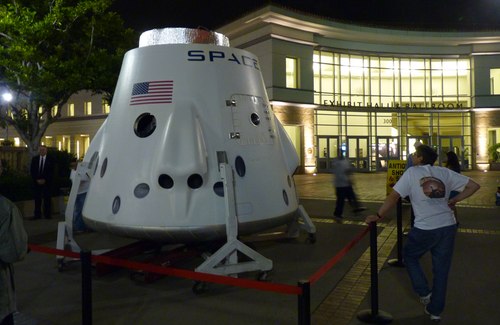 A mockup of the crewed version of the Dragon spacecraft on display Friday night outside the Pasadena Convention Center, which is hosting The Planetary Society’s PlanetFest and The Mars Society’s annual conference this weekend. (credit: J. Foust) [ First in a series of posts about the companies that won and lost in NASA’s Commercial Crew Integrated Capability (CCiCap) competition ]
Of all the companies involved in the CCiCap competition, SpaceX was widely considered to have an inside track to win one of the awards. Just over two months ago it successfully demonstrated its ability to deliver cargo to the International Space Station using its Falcon 9 rocket and Dragon spacecraft, vehicles that would be used, with upgrades and safety improvements, to ferry astronauts as well. So did that explain why SpaceX CEO Elon Musk sounded relatively restrained on a conference call with reporters Friday morning, after the awards were announced?
No. Instead, he was simply a little tired. “I’ve actually just gotten very little sleep because I was quite keen to hear the announcement this morning, so I only got a few hours of sleep,” he explained. (The announcement of the CCiCap awards was made at 6 am Pacific time.) “I’m actually super excited about it.”
The SpaceX CCiCap award includes 14 milestones, though critical design review, with a total value of $440 million. Those milestones include a pad abort test of the Dragon’s escape thrusters, as well as an in-flight abort test, where the Dragon uses its thrusters to escape from its Falcon 9 launcher during ascent. Both of those tests are slated to take place from the SpaceX launch site at Cape Canaveral, although Musk suggested in the telecon that at least the pad abort test could take place elsewhere as a safety issue.
Musk said he believed that SpaceX has an advantage over Boeing and Sierra Nevada because of the company’s long-term vision of putting people into space. “Human spaceflight has been the goal of SpaceX since the beginning, so the way we’ve designed the Falcon 9 and Dragon is to comply as best we can with the NASA human rating requirements,” he said. “If someone were to stow away on the cargo version of Dragon, they would have actually been fine on the last mission.”
Musk played up the economic benefits the company could provide to Florida, envisioning 1,000 jobs at its Cape Canaveral launch site within four to five years, plus several times that in indirect jobs linked to those activities. He said SpaceX would put “hundreds of millions of dollars” of its own money into the crew development project, which he estimates will have an overall cost of about $1 billion.
“It should make for some really exciting stuff for the American space program in the years ahead,” he said at the end of the brief conference call. “We look forward to doing a good job for NASA and the American people and scoring a few goals for the home team here.”
NASA announced this morning that, as reported last night, Boeing, Sierra Nevada Corporation, and SpaceX have all received funded Space Act Agreements for the Commercial Crew Integrated Capability (CCiCap) phase of the agency’s commercila crew efforts. Boeing and SpaceX appear to have won the two “full” awards, receiving $460 million and $440 millon respectively, while Sierra Nevada got the “half” award, at $212.5 million. More details will be forthcoming with a press conference at the Kennedy Space Center at 10 am EDT, and a press telecon to follow.
On Friday morning NASA will announce the winners of the Commercial Crew Integrated Capability, or CCiCap, awards, the next phase of the agency’s commercial crew program. Already some news is leaking out about the awardees: both the Wall Street Journal and NBCNews.com report that Boeing, Sierra Nevada, and SpaceX will receive funded awards, with apparently Boeing and SpaceX getting “full-sized” awards and Sierra Nevada a smaller one, complying with the agreement between NASA and key House appropriator Rep. Frank Wolf (R-VA) to make no more than “two and a half” awards.
However, more than just those three companies submitted awards. ATK made a major push for its Liberty concept, and it’s possible Blue Origin (who, along with Boeing, Sierra Nevada, and SpaceX, had funded second-round commercial crew development, or CCDev-2, awards) and Excalibur Almaz (which had an unfunded CCDev-2 agreement) may have submitted proposals as well. What will these companies do going forward without a funded CCiCap agreement from NASA?
For Blue Origin, the company is likely to continue progress at a slower, but self-funded pace, relying on the investment that founder Jeff Bezos has made in the company since its inception. Excalibur Almaz, meanwhile, has shown an interest in commercial activities beyond Earth orbit: the company has been pushing circumlunar and deep space missions, seeing better opportunities there than in Earth orbit. Company officials speaking at the NSS’s International Space Development Conference in Washington, DC, in May suggested the company primarily sought an unfunded CCDev-2 agreement to permit some technical interchange with NASA to support the company’s future plans beyond LEO.
ATK is another story, though: the company has invested significantly in its push for a CCiCap award, including a media blitz in the last month. Company officials have suggested they would continue to pursue the program, but at a slower pace, without NASA funding. At the NewSpace 2012 conference last week, ATK’s Kent Rominger outlined an aggressive schedule for Liberty that called for flight tests beginning in 2014 and crew flights starting in 2015, but that schedule depends on winning a full CCiCap award. Rominger said NASA asked them what would happen if they got only two-thirds of their requested funding. “My schedule went out about seven months,” he said. “Proportionally from there it just continues to go out further to the right with less funding.”
And what if the reports are wrong and it’s Sierra Nevada left out of the CCiCap awards? Mark Sirangelo, head of Sierra Nevada Space Systems, also spoke at NewSpace 2012 and, during a luncheon address, talked about the perseverance the company had in the past trying to win a different NASA contract, which they finally did after several setbacks. Does that mean the company has a Plan B if they don’t win a CCiCap award? “Yeah, we have a Plan B, Plan C, Plan D,” he said. He declined to go into details about what those backplan plans are, though, saying he would want to consult with his “space family”—those working on the Dream Chaser program—before making any decisions on those plans. “We will discuss those contingency plans if necessary. This is not the time or place to do that.”
The field of commercial suborbital spaceflight will get a rare moment in the Capitol Hill spotlight today when the House Science, Space, and Technology Committee’s space subcommittee will hold a hearing titled “The Emerging Commercial Suborbital Reusable Launch Vehicle Market” at 2 pm EDT; the hearing will be webcast. The hearing features representatives of three suborbital vehicle developers: George Whitesides, president and CEO of Virgin Galactic; Andrew Nelson, COO of XCOR Aerospace; and Brett Alexander, director of business development and strategy for Blue Origin. Also at the hearing are Alan Stern of the Southwest Research Institute and Stephan R. McCandliss of Johns Hopkins, talking about the research potential of suborbital vehicles, and Carissa Christensen of the Tauri Group, talking about her company’s latest assessment of suborbital markets.
The hearing charter primarily provides an overview of the emerging suborbital industry. The “overarching questions” section suggests that the hearing will primarily be an information-gathering one for the committee, learning more about suborbital companies and markets, as well as the industry’s relationship with its primary regulator, the FAA’s Office of Commercial Space Transportation (AST).
Tied to the hearing is the release by FAA/AST of the report “Suborbital Reusable Vehicles: A 10-Year Forecast of Market Demand”, prepared by the Tauri Group and funded jointly by FAA/AST and Space Florida. The report measures demand in “seat/cargo equivalents” to accommodate both crew and cargo suborbital flights. The report’s baseline forecast calls for growth in demand from 373 seat/cargo equivalents in the first year of regular vehicle operations to 533 in the 10th year.
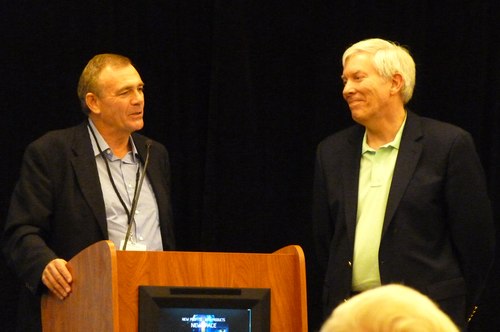 Neil Milburn (left) of Armadillo Aerospace speaks at the NewSpace 2012 Conference on Thursday after receiving a launch license from George Nield (right), associate administrator for commercial space transportation at the FAA. (credit: J. Foust) Armadillo Aerospace is one step closer to flying a rocket into space after receiving a launch license from the FAA on Thursday. During a brief presentation at the NewSpace 2012 Conference in Santa Clara, California, FAA associate administrator for commercial space transportation George Nield awarded Armadillo a suborbital reusable launch vehicle license for its STIG-B rocket. Nield noted that this is only the third such licensed awarded by the FAA, after ones given to Scaled Composites and XCOR Aerospace, and is the only currently-active suborbital RLV launch license.
Neil Milburn, Armadillo’s vice president of program management, praised the FAA Office of Commercial Space Transportation (AST) for the speed in which it awarded the license. “AST is allowed by law 180 days to review your license [application] and say yea or nay,” he said. “This time around they did it in 63 days, which I’m pretty sure is a record.”
Armadillo is planning the first launch of the STIG-B the weekend of August 25-26 at Spaceport America in New Mexico, with of goal of reaching an altitude of 100 kilometers. While previous launches of Armadillo’s STIG rockets were done under waivers, the performance of the rocket, as well as the fact that the launch is generating revenues from payloads onboard (it’s carrying experiments for Europe’s Vega Space and the University of Purdue) required a full-fledged launch license. The launch would also qualify Armadillo to carry payloads for NASA’s Flight Opportunities program.
The rocket itself is still coming together at Armadillo’s Texas facility. “It should be together as a complete vehicle in the next ten days,” he said. There’s also a series of verification tests, integration of the experiment payloads, and hot-fire tests of the engine planned before the launch. Last weekend, he said, they were in Arizona doing drop tests of the vehicle’s recovery system, which includes a steerable parafoil to bring the vehicle back to the launch site. “There’s a lot of work to do in the next three, four weeks.”
Milburn said they eventually plan to fly STIG-B on a monthly basis, building up experience that they will fold into their later plans for a suborbital crewed vehicle, Hyperion. “One of the things we wanted to do with the STIG family of vehicles is to use it as a flying testbed for all of the technologies we need to fly the Hyperion-class vehicle,” a two-person suborbital vehicle. “Our philosophy has always been to learn your lessons at the lowest possible cost with the smallest possible vehicle as quickly as you can. And fly often, because that’s when you find out where all the weak areas are.”
Most of Wednesday’s announcement by Virgin Galactic focused on its rejuvenated smallsat launch system, LauncherOne. The company, though, did offer a brief update on its suborbital spaceflight plans. According to the release, the company now has “confirmation that all major components of SpaceShipTwo’s rocket system have been qualified for powered flight, on track to begin before the year’s end.” The release cited “a flurry of recent test activity”, which is clear from the test logs for its RocketMotorTwo hybrid rocket engine and SpaceShipTwo itself.
Virgin also announced it had just signed up its 529th customer, which it considered a milestone itself. That’s because, since the Space age began, only 528 people have flown to space (many, of course, multiple times). Thus, within about the first 90 commercial SpaceShipTwo flights, Virgin will double the number of people who have been to space in history. Those commercial flights, Branson said Wednesday, are scheduled to begin by the end of 2013.
Much of the media coverage of Wednesday’s event, though, focused on a bit of old news. Various outlets, including the AP, reported that Branson and his two adult children will go on the first commercial SS2 flight. While that was a “revelation” to the AP, Branson has said for several years, such as this 2009 report, that he and members of his family would go on that initial commercial flight—part show of confidence in the service, and part publicity stunt, to be sure. The British tabloid The Sun went on to report that Branson “is to name the Virgin Galactic mothership after his own mother, Eve.” That naming of the first WhiteKnightTwo airplane as the “VMS Eve” already took place—in July 2008.
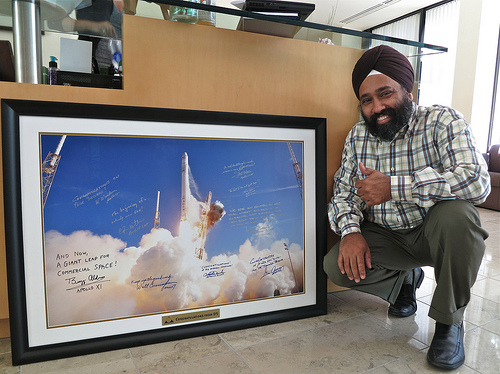 A photo of a SpaceX Falcon 9 launch, bearing the signatures and messages of nine Apollo astronauts collected by venture capitalist Steve Jurvetson. His colleague, Mohanjit Jolly, is kneeling next to the photo. (credit: Steve Jurvetson/Flickr) There is a perception of a rift between the “old guard” of established aerospace companies, as well as the astronauts who flew on some of NASA’s most historic missions, with the emerging entrepreneurial NewSpace companies, exemplified by SpaceX. That division was evident in a 60 Minutes segment about SpaceX, which originally aired in March and reaired early last month, after SpaceX’s successful flight to the ISS. The segment included a clip of testimony by Apollo 17 commander Gene Cernan critical of the administration’s emphasis on commercial space, and Musk’s reaction. “I was very sad to see that because those guys are– yeah. You know, those guys are heroes of mine, so it’s really tough,” he said. Asked if he expected Cernan and other former astronauts to support his efforts, he said, “Certainly hoping they would.”
Steve Jurvetson, a venture capitalist who has invested in SpaceX, saw the 60 Minutes segment and decided to do something about it. That something is shown in a photo on his Flickr photo-sharing account: a picture of a Falcon 9 launch signed by nine Apollo astronauts, with messages of thanks and encouragement to Musk and SpaceX. Those signing the photo include Buzz Aldrin, Alan Bean, and Fred Haise. “And now, a giant leap for commercial space!” was Aldrin’s message.
Jurvetson wanted to get Cernan to tour SpaceX’s factory, as Musk offered in the 60 Minutes segment, but had no success. He did approach him, though, to get him to sign the photo, explaining to him the person effort and funding that Musk put into the company. Cernan agreed, with a message that both offered congratulations and, perhaps, a little advice: “Congratulations on a job well done – now the challenge begins…”
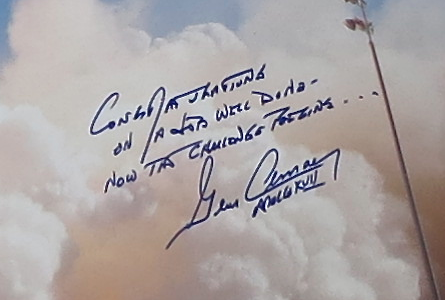 A closeup of the portion of the photo with Gene Cernan’s message and autograph. (credit: Steve Jurvetson/Flickr) Cernan, Jurvetson recalls, asked a lot of questions about the company and its funding. “As I told him these stories of heroic entrepreneurship, I could see his mind turning,” Jurvetson wrote. “He found a reconciliation: ‘I never read any of this in the news. Why doesn’t the press report on this?'” In fact, many of the ups and downs about SpaceX that Jurvetson recounted to Cernan have been reported in the media—including during a certain 60 Minutes segment.
|
|








Recent Comments